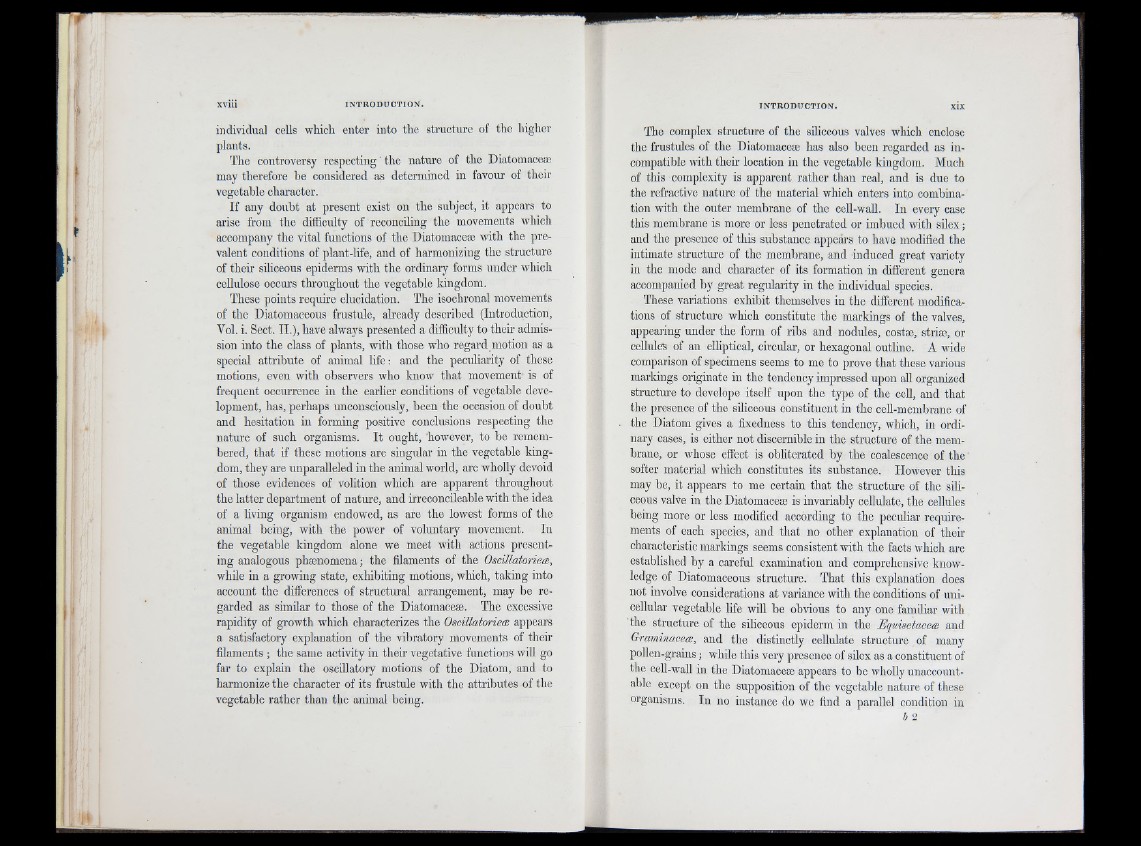
individual cells which enter into the structure of the higher
plants.
The controversy respecting ' the nature of the Diatomaceæ
may therefore be considered as determined in favom- of their
vegetable chai-acter.
If any doubt at present exist on the subject, it appears to
arise from the difficidty of reconciling the movements which
accompany the vital functions of the Diatomaceæ with the prevalent
conditions of plant-life, and of harmonizing the structure
of theii’ siliceous epiderms with the ordinary forms under which
cellulose occurs throughout the vegetable kingdom.
These points require elucidation. The isochronal movements
of the Diatomaceous friistide, already described (Introduction,
Vol. i. Sect. II.), have always presented a difficulty to their admission
into the class of plants, with those who regard motion as a
special attribute of animal life : and the peculiarity of these
motions, even with observers who know that movement is of
frequent occurrence in the earlier conditions of vegetable development,
has, perhaps unconsciously, been the occasion of doubt
and hesitation in forming positive conclusions respecting the
nature of such organisms. It ought, however, to be remembered,
that if these motions are singular in the vegetable kingdom,
they are unparalleled in the animal world, are wholly devoid
of those evidences of volition which are apparent throughout
the latter department of nature, and irreconcileable with the idea
of a living organism endowed, as are the lowest forms of the
animal being, with the power of voluntary movement. In
the vegetable kingdom alone we meet with actions presenting
analogous phænomena ; the filaments of the Oscïllatorieæ,
while in a growing state, exhibiting motions, which, taking into
account the differences of structural arrangement, may be regarded
as similar to those of the Diatomaceæ. The excessive
rapidity of growth which characterizes the Oscïllatorieæ appears
a satisfactory explanation of the vibratory movements of their
filaments ; the same activity in their vegetative functions will go
far to explain the oscillatory motions of the Diatom, and to
harmonize the character of its frustule with the attributes of the
vegetable rather than the animal being.
The complex structure of the siliceous valves which enclose
the frustules of the Diatomaceæ has also been regarded as incompatible
with their location in the vegetable kingdom. Much
of this complexity is apparent rather than real, and is due to
the refractive nature of the material which enters into combination
with the outer membrane of the cell-wall. In every case
this membrane is more or less penetrated or imbued with silex ;
and the presence of this substance appears to have modified the
intimate structure of the membrane, and induced great variety
in the mode and character of its formation in different genera
accompanied by great regularity in the individual species.
These variations exhibit themselves in the different modifications
of structure which constitute the markings of the valves,
appearing under the form of ribs and nodules, costæ, striæ, or
cellule's of an elliptical, circular, or hexagonal outline. A wide
comparison of specimens seems to me to prove that these various
markings originate in the tendency impressed upon all organized
structure to develope itself upon the type of the cell, and that
the presence of the siliceous constituent in the cell-membrane of
the Diatom gives a fixedness to this tendency, which, in ordinary
cases, is either not discernible in the structure of the membrane,
or whose effect is obhterated by the coalescence of the
softer material which constitutes its substance. However this
may be, it appears to me certain that the structure of the siliceous
valve in the Diatomaceæ is invariably cellulate, the cellules
being more or less modified according to the peculiar requirements
of each species, and that no other explanation of their
characteristic markings seems consistent with the facts which are
established by a carefrd examination and comprehensive knowledge
of Diatomaceous structure. That this explanation does
not involve considerations at variance with the conditions of unicellular
vegetable life will be obvious to any one familiar with
the structure of the siliceous epiderm in the Eqidsetaceoe and
Graminaceæ, and the distinctly cellulate structure of many
pollen-grains ; while this very presence of silex as a constituent of
the cell-wall in the Diatomaceæ appears to be wholly unaocount-
able except on the supposition of the vegetable nature of these
organisms. In no instance do we find a parallel condition in
b 2